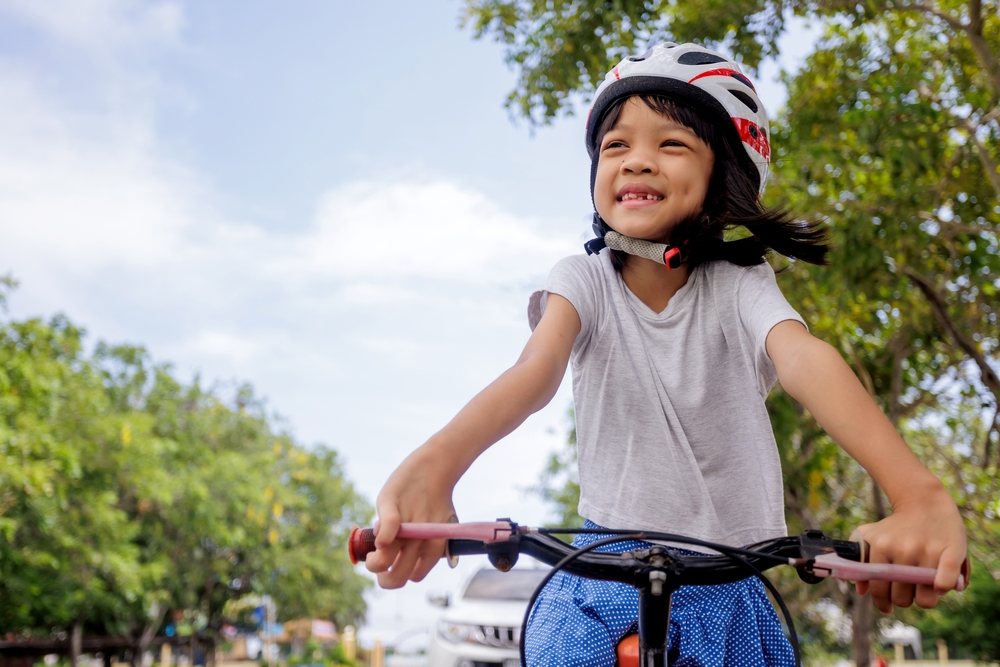
The appropriate age to start riding bikes is usually from 4 to 8, but it depends on the kid's physical development, environmental conditions, and other similar aspects because it's vital that kids have good coordination before learning to ride a bike.
A lot of kids learn to ride a bike at age 5 or 6, which is good because kids are better prepared since their physical and cognitive development is already at a higher level for learning and they can follow safety tips. For example, younger kids may not be able to react quickly enough since their cognitive abilities are still developing, so they could equate bike riding with negativity and pain because of a bad experience like a fall.
To equip you and your child with better bike safety, Malika Yuldasheva, a paediatric medical practitioner specialising in children's physical development, offers her insight.
Safety Tips for Riding Bikes
Proper Helmet Usage
"Proper helmet use can significantly reduce the risk of any injuries, especially brain injuries. For instance, if the child's skull is still developing, the helmet can absorb impact from a fall," says Yuldasheva.
A helmet should be in a proper size since it only works when it's fitted well for kids' heads.
Ways to encourage helmet-wearing:
- Deny kids from riding a bike if they don't have a helmet on.
- Parents can wear their own to encourage kids to wear it too.
- Engage the child during helmet purchasing by letting them pick out the colour or design.
"One more tip, because I'm also a mother, is it's better to start with a helmet even if it's a safe surrounding for bike riding. This can help explain to them what the consequences could be if they don't wear it," says Yuldasheva.
Hand Signals and Road Rules
"I think you need to be patient to teach them these rules. It's not only to keep your baby safe but also to teach them to obey the rules, which will be helpful for the future to be responsible, such as when they grow up and drive a car," says Yuldasheva.
So, every kid should know how and when to handle the signals and to pay attention to other bike riders and motorists. To help with this, you can try these tactics:
- Demonstrate different hand signals for the kids to explain their meanings.
- Practice the signals before they ride a bike so they know how to do them properly when they're riding, they could get nervous.
- Use some visual aids, like diagrams or videos, or pretend play for the kids to learn it. "For example, you can prepare a scenario where hand signals are relevant and have your kid lead and learn from it," suggests Yuldasheva.
Weather-Appropriate Clothing
Some ways to prepare your child for wintery weather and its dangers while bike riding are:
- Buy your kids bright-coloured water-resistant clothing with reflective parts on it so other drivers can see them, and the kids can stay warm.
- Purchase fenders for the bike to help keep kids dry and comfortable in rainy weather.
- Invest in bike lights or lead lights for better visibility in poor weather.
- Ensure the bike has reflective stickers on it to further ensure visibility.
- Supervise your child, especially if they're a young age.
- Teach your kid how to handle bike riding in rainy weather, such as slowing down since the ground is slippery and more dangerous.
Tip: "Engage your child by letting them choose their weather-appropriate clothing as this can help encourage them to wear it and keep them happier while riding," says Yuldasheva.
Bike Maintenance
Maintenance is an important part of safety and the bike's longevity. It's suggested that bike checks should be done routinely. For example, inspections may be every two or three days. Checks should include:
- Handlebars
- Tyre pressure
- Seat secureness
- Chain lubrication
- Whether the chains are working well with the wheels
Teaching your kids bike maintenance can help improve their motor skill development and their problem-solving abilities.
Selecting Appropriate Bike Paths
- For kids who are 3 to 6 years old, it's best to find a place that's flat without any obstacles and safe. For example, a park or some free parking lots.
- For older kids, such as 8- to 12-year-olds, low-traffic places that are a bit more challenging can help improve their bike-riding skills and encourage exploration, as long as supervision is in place.
- Children who are 13 or older can tackle regular roads as long as they're well-versed in the proper safety and road rules.
Safety First to Boost Bike-Riding Fun
Preparing your kids for bike riding involves proper clothing, helmets, and reflectors, and teaching them how to navigate their surroundings. With pretend play and demonstrations, like with diagrams, you can help ensure your child is ready.
This is a big adventure for parents too. To help prepare, getting the right bike or trike is also crucial, and SmarTrike has a wide range, with features such as shock absorption and parental control. So why not make safety fun?









